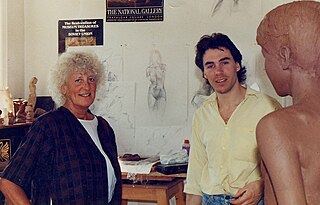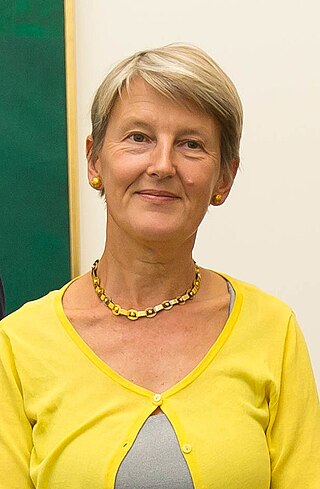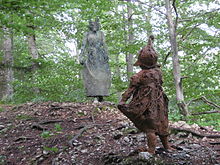
The Victoria and Albert Museum in London is the world's largest museum of applied arts, decorative arts and design, housing a permanent collection of over 2.27 million objects. It was founded in 1852 and named after Queen Victoria and Prince Albert.

Iakovos "Jake" Chapman and Konstantinos "Dinos" Chapman are British visual artists, previously known as the Chapman Brothers. Their art explores deliberately shocking subject matters; for instance, in 2008, they produced a series of works that appropriated original watercolours by Adolf Hitler. In the mid-1990s, their sculptures were included in the YBA showcase exhibitions Brilliant! and Sensation. In 2003, the two were nominated for the annual Turner Prize but lost out to Grayson Perry. In 2013, their painting One Day You Will No Longer Be Loved III was the subject of Derren Brown's Channel 4 special The Great Art Robbery.

Sir Jacob Epstein was an American-British sculptor who helped pioneer modern sculpture. He was born in the United States, and moved to Europe in 1902, becoming a British subject in 1910.

Dame Elisabeth Jean Frink was an English sculptor and printmaker. Her Times obituary noted the three essential themes in her work as "the nature of Man; the 'horseness' of horses; and the divine in human form".
Bernard Cohen is a British painter. He is regarded as one of the leading British abstract artists of his time.

Sheila Hicks is an American artist. She is known for her innovative and experimental weavings and sculptural textile art that incorporate distinctive colors, natural materials, and personal narratives.

Henry Spencer Moore was an English artist. He is best known for his semi-abstract monumental bronze sculptures which are located around the world as public works of art. Moore also produced many drawings, including a series depicting Londoners sheltering from the Blitz during the Second World War, along with other graphic works on paper.
Mark Leckey is a British contemporary artist. His found object art and video pieces, which incorporate themes of nostalgia and anxiety, and draw on elements of pop culture, span several works and exhibitions. In particular, he is known for Fiorucci Made Me Hardcore (1999) and Industrial Light and Magic (2008), for which he won the 2008 Turner Prize.

Bettina Shaw-Lawrence, also known as Betty Shaw-Lawrence, was an English figurative artist. Shaw studied painting and drawing under Fernand Léger, Cedric Morris and Arthur Lett-Haines, though she was mainly self-taught and worked professionally until the early 1980s.
Andy Holden is an artist whose work includes sculpture, large installations, painting, music, performance, animation and multi-screen videos. His work is often defined by very personal starting points used to arrive at more abstract, or universal philosophical questions.

Glenys Barton is a sculptor working mainly in ceramic and bronze.

Phillip King PRA was a British sculptor. He was one of Anthony Caro's best-known students, even though the two artists were near contemporaries. Their education followed similar trajectories and they both worked as assistants to Henry Moore. Following the "New Generation" show at the Whitechapel Gallery, both Caro and King were included in the seminal 1966 exhibit, "Primary Structures" at the Jewish Museum in New York representing the British influence on the "New Art". In 2011, his work was represented in the Royal Academy exhibition on Modern British Sculpture which explored British sculpture of the twentieth century.
Kim Lim (1936–1997) was a Singaporean-British sculptor and printmaker of Chinese descent. She is most recognized for her abstract wooden and stone-carved sculptures that explore the relationship between art and nature, and works on paper that developed alongside her sculptural practice. Lim's attention to the minute details of curve, line and surface made her an exponent of minimalism.
Veronica Maudlyn Ryan is a Montserrat-born British sculptor. She moved to London with her parents when she was an infant and now lives between New York and Bristol. In December 2022, Ryan won the Turner Prize for her 'really poetic' work.

Penelope Curtis is a British art historian and curator. Fom 2015 to 2020 she was the director of Lisbon's Museu Calouste Gulbenkian, and from 2010 to 2015 director of Tate Britain. She is the author of several monographs on sculpture and has written widely at the invitation of contemporary artists.

Diana Widmaier Picasso is a French art historian specialized in modern art, living in Paris.

Katherine Gili is a British sculptor. Born in Oxford in 1948, is the daughter of Catalan publisher and translator Joan Gili and sister of the film-maker Jonathan Gili. She graduated from Bath Academy of Art in 1970 and then studied for two years at St Martin's School of Art. Gili subsequently taught at a number of art schools; most notably St Martin's and Norwich between 1972 and 1985.
Deanna Petherbridge was a South African and British artist, writer and curator. Petherbridge's practice was drawing-based, although she also produced large-scale murals and designed for the theatre. Her publications in the area of art and architecture were concerned with contemporary as well as historical matters, and in latter years she concentrated on writing about drawing. The Primacy of Drawing: Histories and Theories of Practice was published June 2010 and curated exhibitions included The Quick and the Dead: Artists and Anatomy, 1997, Witches and Wicked Bodies, 2013. She celebrated a retrospective exhibition of her drawings at Whitworth Art Gallery, University of Manchester accompanied by the monograph Deanna Petherbridge: Drawing and Dialogue, Circa Press, 2016.

Hilda Annetta Walker FRSA was an English sculptor, and a painter of landscapes, seascapes and horses, flourishing between 1902 and 1958. She was a war artist painting in England during the First and Second World Wars, and described as "escapist". Some of her early work was the production of oilette postcard paintings for Raphael Tuck & Sons, of firemen and horses. She was born in Mirfield, Yorkshire, England, to a family of blanket manufacturers who had the means to foster her art education. She grew up in the Protestant work ethic of Congregationalism, and attended Leeds College of Art, where she studied under William Gilbert Foster of the Staithes group and William Charles Holland King, sculptor of Dover Marine War Memorial. She signed her works "Hilda Walker" or sometimes "Hilda A. Walker".
Angela Mary Flowers was a British gallerist who founded Flowers Gallery, a commercial art gallery that today operates in London, New York City, and Hong Kong. A director of the gallery, she was based between Ramsgate in Kent and Cork in Ireland.

















